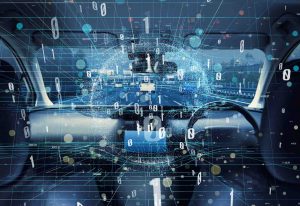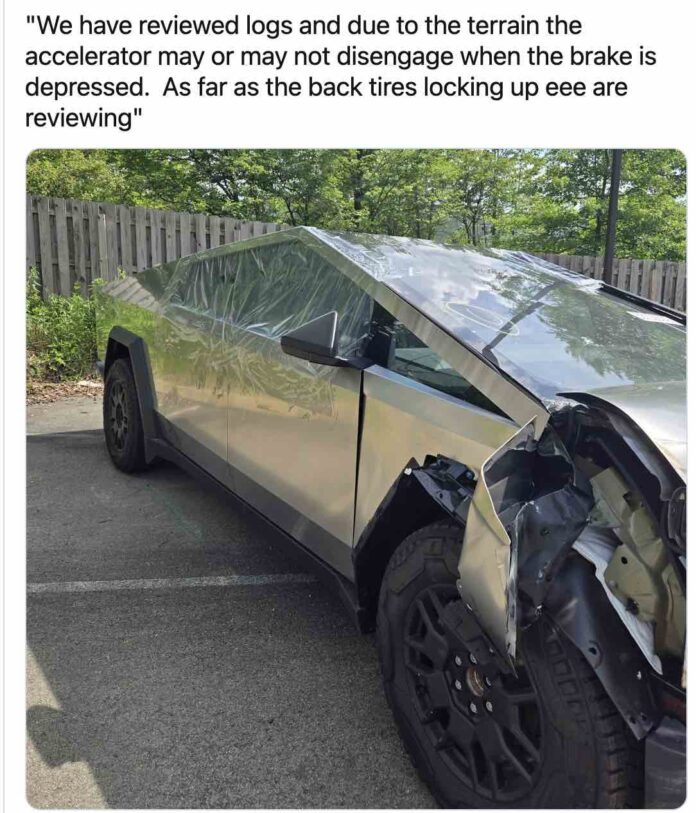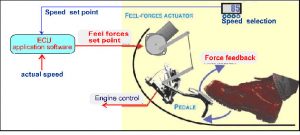You may have heard about the Audis – back in the ’80s – that supposedly accelerated unintentionally. It turned out it was their owners who accelerated their Audis, unintentionally. They inadvertently pushed on the accelerator pedal, that is – when they thought they were pushing down on the brake pedal. The harder they pushed – thinking this would stop their Audi from accelerating – the faster it went.
Until something stopped it, such as whatever fixed object happened to be in the way of the unintentionally accelerating Audi driver.
Today we have Teslas that accelerate unintentionally.
And there’s not much the driver can do about it – because it isn’t the driver that’s doing it.
Back in the ’80s, cars had throttle cables connected to their accelerator pedals. These could stick and sometimes did. But you could always (if you were nimble) reach down and pull the pedal up, to unstick the pedal and stop the engine (and so, the car) from accelerating. Failing that, you could just put the transmission in neutral, to disconnect the engine from the transmission and – thereby – the engine from the drive wheels. The engine would still rev – assuming the throttle cable was still stuck – but the car would stop accelerating.
Today, acceleration is not directly controlled by the accelerator pedal. Not in a mechanically connected sense, at any rate. Pushing down on the pedal sends an electronic signal to the computer that controls the engine (or the electric motors, in the case of battery powered devices like Teslas) and the computer then tells the engine (or the motors) how fast to spin.
Unintended acceleration – as in the case of the Tesla Cybertruck that just did exactly that – occurs when the computer decides to accelerate the vehicle. This is the distinction that makes all the difference between the ’80s (and prior) and today. Put another way, it isn’t the driver that causes the vehicle to accelerate – intentionally or not.
And when they glitch, there’s very little the driver can do. Attempting to unstick the accelerator pedal won’t do anything. It is as futile an effort as trying to send a punch-in-the-face over your sail fawn to the “customer service” AI drone on the other end of the sail fawn. You might not even be able to put the transmission in neutral because there is only an electronic connection between your hand and the transmission. When you move the selector from Park to Drive, it is the computer that is putting the transmission in Drive. No cable pulls on anything.
Electronic signals are sent, is all.
The computer that controls it all is controlled by its software parameters and if those do not allow the driver to select neutral while the vehicle is moving – so as to sever the mechanical connection between a run-away engine and the transmission – then the vehicle will continue to accelerate. Devices such as the Tesla Cybertruck don’t even have transmissions as a potential intercessory measure. The motors directly spin the drive wheels – and if the computer says to keep on spinning, they will do exactly that and the device will continue accelerating – until something stops it. Such as the house the driver of the Cybertruck that’s in the news ran into.
According to Yahoo news – such as it is – Tesla’s response to the running-amok of its Cybertruck was as follows:
“We have reviewed logs and due to the terrain the accelerator may or may not disengage when the brake is depressed.”
Behold modernity.
Also behold something else. Note that bit about “we have reviewed the logs.” This was not possible back in the ’80s, when Audis didn’t unintentionally accelerate but were accused of it on account of their drivers doing it. Audi was almost put out of business by it. It took Herculean effort to prove that it was not the cars but the drivers who unintentionally accelerated.
Today, Tesla admits – openly and unabashedly – that its devices’ accelerators “may or may no disengage.” It also knows all about its devices unintentional acceleration – because it has “reviewed the logs.” Tesla is watching you, in other words. Wherever you go, whatever you do, Tesla is aware. It has the logs. And these are not the old-timey Event Data Recorders that cars have had since the late ’90s; these had to be physically removed from the vehicle to obtain the logs. There were court cases haggling over who owned the data within them.
No more need for haggling – because the data is already out of the box. It gets transmitted, like telemetry to the Tesla Hive Mind. This data is then used to assess how much to mulct you for insurance coverage – neatly provided in-house, by Tesla.
But it isn’t just Tesla, unfortunately. If it were, you could opt out by not buying one of their devices. But all new vehicles are devices in the sense that they send and receive data – and you have no control over it.
Just as you have no real control over its acceleration, either.
. . .
If you like what you’ve found here please consider supporting EPautos.
We depend on you to keep the wheels turning!
Our donate button is here.
If you prefer not to use PayPal, our mailing address is:
EPautos
721 Hummingbird Lane SE
Copper Hill, VA 24079
PS: Get an EPautos magnet or sticker or coaster in return for a $20 or more one-time donation or a $10 or more monthly recurring donation. (Please be sure to tell us you want a magnet or sticker or coaster – and also, provide an address, so we know where to mail the thing!)
If you like items like the Baaaaaa! baseball cap pictured below, you can find that and more at the EPautos store!













Having no real control over the acceleration. How lovely. That makes it so much easier for the powers that be to kill someone they do not like (or did not obey/get their jabs/fill-in-the-blank), and claim it was the bad driver, or simply “mechanical failure”.
Had an incident of intentional “unintended acceleration” 30 years ago.
Throttle cable stuck in a Pontiac 6000 when I jabbed it hard to pass traffic, and away I went!!!
But in town, with a 45 MPH limit, it was not a “safe space” to let it rip WFO.
After a real quick assessment, tried turning it off, but lost brakes and steering, so had to re-start and drop the gearshift into Neutral, and a power brake slide into the nearest parking lot, popped the hood, and a quick tug on the throttle cable assembly released the stuck cable and it dropped back down to normal engine speed.
It actually helped a lot that it was only the 2.5L Iron Duke engine, which was anemic on it’s best day, but the experience still left me with a bit of a “Richard Petty” feeling for a few days.
Thank goodness for physical mechanical connections…
Good times, good times….
Remember the good old days when you’d just roll the key back one notch and the engine would shut off but you still had steering and braking, albeit manual? What happens with new cars if you push the stop button on the dash or do you have to hold it down on a misbehaving computer system? I’ll have to ask my mechanic about this.
Always consequences with too much cyber technology, can’t be avoided. The ‘Let It Burn’ world is here, doesn’t matter where.
There was a recall on my vehicle, an airbag issue, recently made an appointment to service the vehicle under warranty, didn’t cost money.
Two days before the appointment, the engine light disappeared and hasn’t returned since. Don’t know why, but it happened just like that. Did the car company do a preliminary update before the day of the appointment? I’m suspicious. Probably not, still makes no sense.
It was uncanny, the vehicle passed the inspection, needs a little brake fluid, installed new pads and rotors a year ago, and also some coolant. Air conditioning will do that.
Always minor issues that are solvable. The airbag system is fine. Cabin filter is new, air filter has been changed.
Uses very little oil at 178,000 miles.
Aging vehicle electronics are getting to be real trouble! Buddy’s 2011 Harley that was in the shop for poor running/cutting out total head scratching repair time about 8 months – two years back, died in my driveway yesterday. Ride the 20 miles to my place no problem. Started it, running a bit funky then quit no restart. Got his trailer, loaded it up, for fun hit the starter and it fired right up. Can’t trust it though so off to the dealer.
Their initial read is a “glitch” between the fob and the bike’s security system. Bikes have a “transport mode” to deactivate the security system for trailering as the jounching around would set off the alarm. He trailers a lot so uses that feature regularly. Well, looks like Mr. Hal computer in the bike has “issues” now going into/out of transport mode. Sheesh.
And – the shortage of techs to fix this stuff. The nearest dealer is 36 miles and their ONE Harley tech (he’s ancient) is in the hospital after tangling with a cager while test riding a bike. Doubt he’ll be back. No one else in the shop is certified. The next dealer is about 80 miles, that’s where he went but again, one certified tech and he works part time. I’m sure the car dealers are facing this issue as the experienced folks age out.
Good luck with your multi computer system CANBUS linked over sensored car or truck!
‘Their initial read is a “glitch” between the fob and the bike’s security system.’ — Sparkey
I was looking at a Ducati Scrambler, but didn’t much care for its cheap and cheesy digital speedo/tach. Why not install an aftermarket unit, I thought. But … NO DICE. The key fob pairing is incorporated into the OEM speedo, which connects to the ECU. Aftermarket units won’t work and aren’t available. So I won’t be buying a Scrambler.
Whereas the Royal Enfield INT 650 I’m now looking at has separate, ANALOG DIAL speedo and tach units, with a simple wire harness connection and no ECU pairing b.s. … AND, a key ignition.
https://sanemotionmoto.com/wp-content/uploads/2024/01/Royal-Enfield-OEM-Triples_4_small.jpg
BAH, CANBUS! I hate that shit, especially on bikes, which were born to be simple.
Oh my, real dials with real pointers, not an electronic facsimile. That’s a tempting setup! And a physical keyed ignition good for them!
Hi Eric ,
Also most steering wheels now are just some type of encoder resistor or whatever sensor connected only by wire to the pc that controls steering. In past you could turn the wheels even if your servo died. Now you are fucked. if something happens. A glitch in software or a hack can make you spin a usles toy wheel without any action happening. All while going with huge speed against the wall
Already the Cyberfuck is living up to it’s name.
I remember one of the automotive magazines did a piece on the unintended acceleration people were experiencing with Toyotas in 2009 or so. They were able to get every car stopped while on full throttle, even a souped up Ford Mustang. The lesson here is most people are not very good drivers and tend to panic if anything goes wrong. Shocking, I know.
In the past few weeks I’ve seen several car haulers toting cybertrux. Never more than 3 or 4 at a time. Are they so heavy they can’t haul more than a few at a time? Do the drivers of these rigs need hazmat certification to transport them?
Any other company would be driven into penury but, not the Musk Rat.
I saw one with 10, but wondered who is buying them? This is in Tucson
So much unnecessary complexity and spyware. With the exception of airbags (which have become deadly in some cases), generally speaking, 1998 – 2002 Japanese vehicles were the pinnacle of automotive engineering and build quality. It’s gone down hill from there.
Why anybody would purchase one of these infernal devices is beyond my comprehension.
Is the motor is so powerful it drags the behemoth uphill with “parking brake” engaged ?
COMPLETELY AGREE. Early 2000s were the high water mark for all brands. Why anyone would want “drive by wire” is beyond me, as well a the stupid screens which have replace knobs and levers.
It wasn’t me! Elon’s words.
Not a good advertisement for the Cybertruck, probably will hurt sales in the future.
Has to be dangerous for anybody driving one.
There will be Cybertruck demolition derbies, won’t need a driver, the Cybertruck will demolish itself in seconds.
Use a PS5 controller and watch from 150 feet of distance away from the melee.
It will be close to crashing train engines at full throttle.
Roosevelt vs. Hoover at the Iowa State Fair, you can see what a train wreck can be.
https://www.pressenterprise.com/2024/06/25/ford-recalls-over-550000-pickups-because-transmission-can-suddenly-downshift-to-1st/
>Documents say the problem is caused by a lost signal between a transmission speed sensor and the powertrain control computer.
>Dealers will update the powertrain control software at no cost to owners,
Heard about that last night.
Crazy. Can’t we just go back to letting the driver choose what gear he wants?
Here’s the story of unintended acceleration and dry French bread that could have killed me in a 2003 chevy malibu! I was driving up a hill over the highway bridge and I had to give it more gas to maintain speed. Problem was when I crested the hill, it was still accelerating and the pedal would not come back, but it was loose. There was a red light at the bottom of the hill, so I had to think fast. Kicking the pedal didnt work, so I put it in neutral and the engine went to red line. At that point, I turned it off and coasted the rest of the way, making a smooth left turn just getting a green light. I went under the hood and it turns out the throttle cable goes to 75% of a wheel to open the throttle. Some animal placed dry solid french bread there which fell into the 25% notch area, preventing it from closing. Chucked the bread and all was well. Could have been really bad if my girl at the time was driving, it would have been a crash 100%
Been seeing these cybertrucks the road, they are quite huge actually. The tesla insurance is actually available to everyone, at least in California because the government wont allow an insurance company that sells only to one manufacturer
‘due to the terrain the accelerator may or may not disengage when the brake is depressed.’ — Tesla
What does terrain have to do with the brake interlock? The video shows a smooth paved road, so extreme jouncing is not an issue.
As Mike alluded to below, maybe the Cybertruck has a Boeing-licensed Maneuvering Characteristics Augmentation System (MCAS) that went haywire. Its locked rear brakes panicked the computer, which screamed ‘Pull up! Pull up!‘ and applied maximum thrust during its controlled ascent into terrain.
Drive by wire, crash by wire. Just wait till we get Automated Emergency Braking (AEB) and vehicles randomly jerk to a dead stop in front of us. It’s a desperate but brilliant ploy: crash more cars, sell more cars. Keeps hospitals afloat too! 🙂
Jim, I don’t know but an educated guess is that they are at the intersection between “hill holding” and dynamic braking. So when you release your pedal on an upslope, the Tesla may first decelerate using dynamic braking, then apply just enough torque to hold the device in place. Makes sense to a programmer and systems designer (especially a young one of an academic bent) while being horrifying and stupid to a truly educated engineer with decades of real world experience.
These kids need supervision. But no company promotes or retains engineers who talk back.
This is almost certainly the issue. All Teslas do not really require the brake pedal. Perhaps one of the only good things about these cars is that if you drive them properly they can be one pedal cars. Regenerative braking happens immediately when you come off the accelerator so brake pads last forever. (Although you save nothing because tire wear is WAY faster on EVs)
In addition to that, all Teslas operate as you described in that they will immediately put themselves in a “hold” mode as if you are holding down the brake pedal. This is a complex calculation and computers are doing the work because it requires several sensors to do this. Force of gravity, motive force, pitch, etc. are all things in this calculation which tells the car to hold you in place as if your foot is on the brake. As Eric mentioned there is -massive- amounts of telemetry being collected every second by Teslas not all that different (though far less complex) than aircraft.
If the computer’s algorithm is off or the math is bad— whoops. So the nifty ‘magic’ that allows a Tesla to perfectly hold itself in place while not moving even on an incline can go horribly wrong if the computers and software that make it happen are not working properly. I would also venture that many Tesla drivers as so addle brained that they scarcely realize you can actually still PRESS the brake pedal too. (Which may or may not work as well)
Interesting; thanks. It would explain why Tesla obscured the technical issue with the nebulous word ‘terrain,’ instead of ‘uphill grade which confused the algorithm.’
I’d bet a Tesla engineer (or contractor) checked in a tiny, innocent-looking code change that passed all the regression tests and ended up in the latest “update” … and ended up destabilizing “hill hold”.
Imagine if that stupid device ended up killing a kid riding his bike on the driveway … or after the crash, burst into flames, trapping and killing the hapless driver.
Once upon a time, there was this field of study called FMEA — Failure Mode and Effects Analysis — where engineers carefully and systematically determine all of the possible failure modes in a given system (or subsystem).
In the “Before Time”, FMEA was always performed on systems whose failure would likely cause death and/or catastrophic property loss.
Back in 1982, very early in my software engineering career, I worked for Garrett AiResearch helping perform FAA-mandated software verification for the computer that operated their APU (auxiliary power unit) for Boeing 757/767 aircraft. The FAA would not certify the APU unless Garrett could prove that its software did exactly what it was supposed to do under every possible circumstance … and there were hundreds of thousands of code paths to verify.
AFAIK, none of this is being done with automotive software. There is no FAA-equivalent to certify automobile software. None of it is open source, and therefore not subject to any kind of public scrutiny. Yet, obviously, lives are at stake.
It begs the question: who in their right mind would choose to have software mediate between driver control inputs and the drivetrain, brakes & steering? Your throttle cable example, Eric, perfectly shows its superiority, because its FMEA matrix is several orders of magnitude smaller than its software counterpart.
In other words, it’s a no-brainer: a mechanical cable is simpler, cheaper and most importantly, safer.
Please God save us from this technological nightmare that arrogant fools have erected around us!
‘Once upon a time, there was this field of study called FMEA.’ — MrBill
I can personally attest that FMEA was required and performed for mass transit vehicles (subway cars) in the 1980s electromechanical era.
Algorithms and cheap chips have swept that all away. Under the right circumstances, every chip-controlled device is another MCAS (Maneuvering Characteristics Augmentation [sic] System) waiting to malfunction.
AI (Artificial Intelligence) will render your ‘hundreds of thousands of code paths’ both mutable and completely untraceable. Welcome to AEB (Automated Emergency Braking), comrade. It’s gonna be a hoot — till you smack into your own smokin’ silhouette like Wile E Frickin Coyote.
Amen, JimH! Great post! We are so screwed…
Speaking of brain power in the “before time” – FMEA a priority in 777 flight control development, Boeing’s first full up fly by wire. I was sitting in on an engineering meeting while they were way deep into failure analysis. Their supervisor got up and from memory started writing math formulas on the white board, discussing with the team as the board filled up with his calculations including the team inputs. Very impressive work and of course a very impressive system for one of the last great aircraft.
We had to do that with the freaking paint
I remember GM having all sorts of problems with their ABS systems in the early-mid 90s, but you could still stop the vehicle. IIRC the hall-effect sensors were too sensitive and would tell the processor the wheels were locked all the time, or just at random times on dry pavement. And dealers tried to blow it off as “normal,” perhaps intentionally failing to understand what the drivers were talking about to avoid a warranty fix.
Last night I was awakened to a flashing light in the hallway. Something I didn’t recognize. Upon investigation I realized it was my WiFi access point getting a software update. These are fairly old devices now, in place for at least 5 years, but Ubiquiti Networks still send out updates once in a while. At this point they’re just bug fixes, no new features to be added.
I’m sure Tesla will release a software update to fix this “bug.” But how did it get past QA testing? Will the logs be dumped and the situation recreated in a simulator ad nauseam until they know it is gone? Or will they just run it back to The Team and let them figure out what they did wrong? Because usually when you go looking for specific software bugs is when you find them. It’s when you don’t know what you’re looking for will you fail to see it.
If my SOHO network equipment is still getting bug fixes after years of use, and decades of devices built, what does that say about software? Especially when the code comes from a “move fast break things” company like Tesla?
The Tesla Cybertruck has all sorts of issues with it besides being the UGLIEST truck I’ve ever seen, such as the edges of the doors and hood being sharp enough to slice vegetables or a human’s hand or fingers….it’s a wonder the government didn’t move to take it off the market……oh wait, they haven’t done that with the “Safe and Effective” COVID jabs either, as they want to SHOVE this crap down everyone’s throats, using “_________ emergency!” as the excuse…….
https://rumble.com/v4rhb85-tesla-cybertruck-is-a-disaster.html
Sounds like the ugly ass Cybertruck devices have 737 Max style hidden “features” that turn deadly.
Hi Mike,
The Cybertruck and other EVs have all sorts of issues with them, but government will likely continue framing them as “Safe and Effective!” in the same way (or similar) it framed those COVID-19 “vaccines”. It has become painfully obvious the past few years that Big Pharma (as well as the military-industrial complex) has TREMENDOUS influence over the federal government, and it increasingly appears to be the same way with the Green energy lobby (or “Big Wind and Solar”) and billionaire sociopaths.